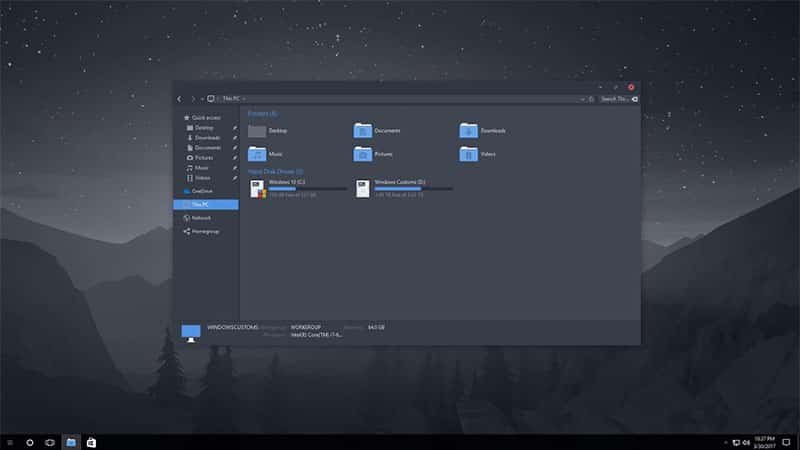A Comprehensive Exploration of How to Install New Themes in Windows 10

Introduction:
Windows 10, Microsoft’s flagship operating system, offers users a customizable interface that can be personalized to suit individual preferences. One of the key elements of this customization is the ability to install new themes, allowing users to change the look and feel of their desktop environment. In this extensive guide, we will delve into the intricacies of installing new themes in Windows 10, exploring various methods, tips, and considerations for a truly tailored computing experience.
Understanding the Significance of Themes:
Themes play a pivotal role in enhancing the aesthetic appeal of Windows 10. They go beyond mere color changes and wallpaper adjustments, offering a cohesive visual experience by modifying the appearance of windows, icons, cursors, and system sounds. Whether you’re aiming for a sleek and modern look or a nostalgic throwback to classic Windows styles, installing new themes opens up a world of creative possibilities.
Method 1: Utilizing the Microsoft Store
The Microsoft Store serves as a convenient and secure hub for downloading and installing themes directly onto your Windows 10 system. Follow these steps to explore and install themes from the Microsoft Store:
- Open the Microsoft Store: Launch the Microsoft Store from the Start Menu or search for it using the Cortana search bar.
- Navigate to the Themes Section: Once in the Microsoft Store, look for the “Themes” section in the navigation menu. Click on it to explore the available themes.
- Browse and Select a Theme: Browse through the collection of themes available in the store. You can preview themes to get a glimpse of how they will transform your desktop.
- Click “Get” or “Install”: After selecting a theme, click on the “Get” or “Install” button to download and install it on your system.
- Apply the Installed Theme: Once the theme is installed, go to Settings > Personalization > Themes, and select the newly installed theme from the list.
Method 2: Downloading Themes from External Sources
For users seeking a broader range of themes beyond what the Microsoft Store offers, downloading themes from external sources is a viable option. Here are the steps to install themes from external websites:
- Choose a Trusted Theme Source: Select a reputable website that offers a variety of Windows 10 themes. Ensure that the themes are compatible with your Windows version and are free from malware.
- Download the Theme Package: Download the theme package from the selected website. Themes often come in compressed files (ZIP format). Extract the contents to reveal the theme files.
- Move Theme Files to the Windows Themes Folder: Navigate to the “C:\Windows\Resources\Themes” directory on your system. Move the extracted theme files into this folder.
- Apply the Theme: Go to Settings > Personalization > Themes, and you should see the newly added theme in the list. Select the theme to apply it to your desktop.
Method 3: Creating Custom Themes with Personalized Settings
Windows 10 also allows users to create custom themes by combining various elements such as wallpapers, accent colors, sounds, and more. Follow these steps to craft a personalized theme:
- Access the Personalization Settings: Go to Settings > Personalization to access the customization options.
- Choose Background, Colors, Sounds, and More: Customize individual elements like background images, accent colors, sounds, and mouse pointers according to your preferences.
- Save Your Custom Theme: Once you’ve adjusted all the settings, click on “Save theme” and provide a name for your custom theme. This will save your personalized configuration for future use.
- Apply Your Custom Theme: Your custom theme will now appear in the Themes section. Select it to apply your personalized settings to the desktop.
Considerations and Tips for Installing Themes:
- Compatibility: Ensure that the themes you download are compatible with your Windows 10 version to prevent any compatibility issues.
- Security: Stick to trusted sources when downloading themes to avoid potential security risks. Microsoft Store and reputable theme websites are generally safer options.
- Backup: Before making significant theme changes, consider creating a backup of your current theme settings to revert in case you encounter any issues.
- Explore Third-Party Tools: Some third-party tools and applications offer advanced theme customization features beyond the built-in options in Windows 10. Explore these tools cautiously and ensure they are reputable and safe to use.
- Regular Updates: Keep your installed themes up to date, especially if they are obtained from external sources, to benefit from any improvements or bug fixes.
Conclusion:
Customizing the visual aspects of your Windows 10 experience through themes is a powerful way to make your computer feel uniquely yours. Whether you prefer a minimalist design, vibrant colors, or a theme that reflects your interests, Windows 10 provides a versatile platform for personalization. By following the methods outlined in this comprehensive guide and considering the tips provided, you can effortlessly install new themes, transforming your desktop into a visually stunning and personalized workspace. Embrace the creative possibilities that Windows 10 themes offer, and make your computing experience truly one-of-a-kind.




